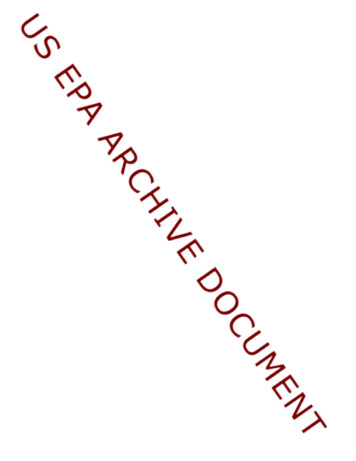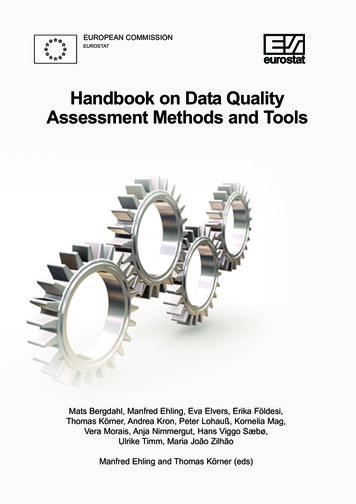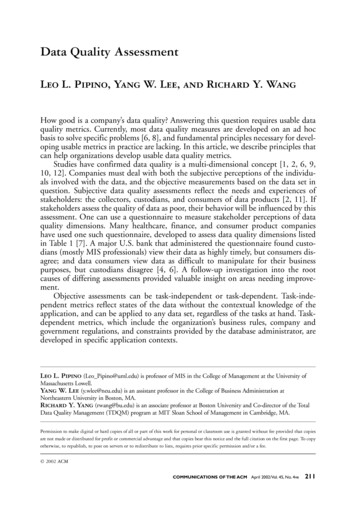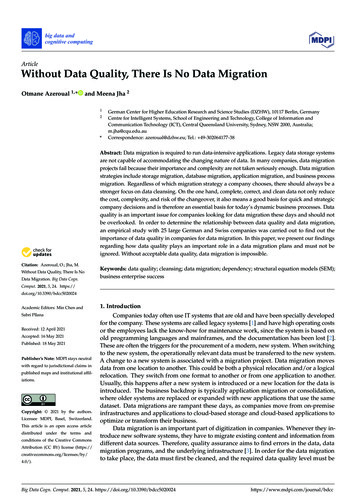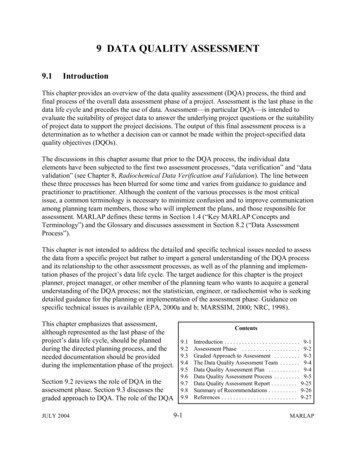
Transcription
9 DATA QUALITY ASSESSMENT9.1IntroductionThis chapter provides an overview of the data quality assessment (DQA) process, the third andfinal process of the overall data assessment phase of a project. Assessment is the last phase in thedata life cycle and precedes the use of data. Assessment in particular DQA is intended toevaluate the suitability of project data to answer the underlying project questions or the suitabilityof project data to support the project decisions. The output of this final assessment process is adetermination as to whether a decision can or cannot be made within the project-specified dataquality objectives (DQOs).The discussions in this chapter assume that prior to the DQA process, the individual dataelements have been subjected to the first two assessment processes, data verification and datavalidation (see Chapter 8, Radiochemical Data Verification and Validation). The line betweenthese three processes has been blurred for some time and varies from guidance to guidance andpractitioner to practitioner. Although the content of the various processes is the most criticalissue, a common terminology is necessary to minimize confusion and to improve communicationamong planning team members, those who will implement the plans, and those responsible forassessment. MARLAP defines these terms in Section 1.4 ( Key MARLAP Concepts andTerminology ) and the Glossary and discusses assessment in Section 8.2 ( Data AssessmentProcess ).This chapter is not intended to address the detailed and specific technical issues needed to assessthe data from a specific project but rather to impart a general understanding of the DQA processand its relationship to the other assessment processes, as well as of the planning and implementation phases of the project s data life cycle. The target audience for this chapter is the projectplanner, project manager, or other member of the planning team who wants to acquire a generalunderstanding of the DQA process; not the statistician, engineer, or radiochemist who is seekingdetailed guidance for the planning or implementation of the assessment phase. Guidance onspecific technical issues is available (EPA, 2000a and b; MARSSIM, 2000; NRC, 1998).This chapter emphasizes that assessment,although represented as the last phase of theproject s data life cycle, should be plannedduring the directed planning process, and theneeded documentation should be providedduring the implementation phase of the project.Section 9.2 reviews the role of DQA in theassessment phase. Section 9.3 discusses thegraded approach to DQA. The role of the DQAJULY tion . . . . . . . . . . . . . . . . . . . . . . . . . . 9-1Assessment Phase . . . . . . . . . . . . . . . . . . . . 9-2Graded Approach to Assessment . . . . . . . . . 9-3The Data Quality Assessment Team . . . . . . . 9-4Data Quality Assessment Plan . . . . . . . . . . . 9-4Data Quality Assessment Process . . . . . . . . . 9-5Data Quality Assessment Report . . . . . . . . . 9-25Summary of Recommendations . . . . . . . . . . 9-26References . . . . . . . . . . . . . . . . . . . . . . . . . . 9-27MARLAP
Data Quality Assessmentteam is discussed in Section 9.4. Section 9.5 describes the content of DQA plans. Section 9.6details the activities that are involved in the DQA process.9.2Assessment PhaseThe assessment phase is discussed in Section 8.2. This present section provides a brief overviewof the individual assessment processes, their distinctions, and how they interrelate. Data verification generally evaluates compliance of the analytical process with project-planand other project-requirement documents, and the statement of work (SOW), and documentscompliance and noncompliance in a data verification report. Data verification is a separateactivity in addition to the checks and review done by field and laboratory personnel duringimplementation. Documentation generated during the implementation phase will be used todetermine if the proper procedures were employed and to determine compliance with project plandocuments (e.g., QAPP), contract-specified requirements, and measurement quality objectives(MQOs). Any data associated with noncompliance will be identified as an exception, whichshould elicit further investigation during data validation.Compliance, exceptions, missing documentation, and the resulting inability to verify complianceshould be recorded in the data verification report. Validation and DQA employ the verificationreport as they address the usability of data in terms of the project DQOs. Data validation qualifies the usability of each datum after interpreting the impacts ofexceptions identified during verification. The validation process should be well defined in avalidation plan that was completed during the planning phase. The validation plan, as with theverification plan or checklist, can range from sections of a project plan to large and detailedstand-alone documents. Regardless of its size or format, the validation plan should address theissues presented in Section 8.3, Validation Plan. Data validation begins with a review ofproject objectives and requirements, the data verification report, and the identified exceptions.The data validator determines if the analytical process was in statistical control (Section 8.5.2, Quality Control Samples ) at the time of sample analysis, and whether the analytical process asimplemented was appropriate for the sample matrix and analytes of interest(Section 8.5.1, TheSample Handling and Analysis System ). If the system being validated is found to be undercontrol and applicable to the analyte and matrix, then the individual data points can be evaluatedin terms of detection (Section 8.5.3.1), detection capability (Section 8.5.3.2), and unusualuncertainty (Section 8.5.3.3). Following these determinations, the data are assigned qualifiers(Section 8.5.4) and a data validation report is completed (Section 8.6). Validated data are rejectedonly when the impact of an exception is so significant that the datum is unreliable.While both data validation and DQA processes address usability, the processes address usabilityfrom different perspectives. Data validation attempts to interpret the impacts of exceptionsMARLAP9-2JULY 2004
Data Quality Assessmentidentified during verification and the impact of project activities on the usability of an individualdatum. In contrast, data quality assessment considers the results of data validation whileevaluating the usability of the entire data set.During data validation, MARLAP strongly advises against the rejection of data unless there is asignificant argument to do so (Chapter 8). As opposed to rejecting data, it is generally preferablethat data are qualified and that the data validator details the concerns in the data validation report.However, there are times when data should be rejected, and the rationale for the rejection shouldbe explained in the data validation report. There are times when the data validator may havebelieved data should be rejected based on a viable concern, yet during DQA, a decision could bemade to employ the rejected data.In summary, data validation is a transition from the compliance testing of data verification tousability determinations. The results of data validation, as captured in the qualified data andvalidation reports, will greatly influence the decisions made during the final assessment process,which is discussed in Section 9.6 ( Data Quality Assessment Process).9.3Graded Approach to AssessmentThe sophistication of the assessment phase and in particular DQA and the resources applied should be appropriate for the project (i.e., a graded approach ). Directed planning for small orless complex projects usually requires fewer resources and typically involves fewer people andproceeds faster. This graded approach to plan design is also applied to the assessment phase.Generally, the greater the importance of a project, the more complex a project, or the greater theramifications of an incorrect decision, the more resources will be expended on assessment ingeneral and DQA in particular.It is important to note that the depth and thoroughness of a DQA will be affected by thethoroughness of the preceding verification and validation processes. Quality control or statementof work (SOW) compliance issues that are not identified as an exception during verification, orqualified during validation, will result in potential error sources not being reviewed and theirpotential impact on data quality will not be evaluated. Thus, while the graded approach toassessment is a valid and necessary management tool, it is necessary to consider all assessmentphase processes (data verification, data validation, and data quality assessment) when assigningresources to assessment.9.4The Data Quality Assessment TeamThe project planning team is responsible for ensuring that its decisions are scientifically soundand comply with the tolerable decision-error rates established during planning. MARLAPrecommends the involvement of the data assessment specialist(s) on the project planning teamJULY 20049-3MARLAP
Data Quality Assessmentduring the directed planning process. This should result in a more efficient assessment plan andshould increase the likelihood that flaws in the design of the assessment processes will bedetected and corrected during planning. Section 2.4 ( The Project Planning Team ) notes that itis important to have an integrated team of operational and technical experts. The data assessmentspecialist(s) who participated as members of the planning team need not be the final assessors.However, using the same assessors who participated in the directed planning process isadvantageous, since they will be aware of the complexities of the project s goals and activities.The actual personnel who will perform data quality assessment, or their requisite qualificationsand expertise, should be specified in the project plan documents. The project planning teamshould choose a qualified data assessor (or team of data assessors) who is technically competentto evaluate the project s activities and the impact of these activities on the quality and usability ofdata. Multi-disciplinary projects may require a team of assessors (e.g., radiochemist, engineer,statistician) to address the diverse types of expertise needed to assess properly the representativeness of samples, the accuracy of data, and whether decisions can be made within the specifiedlevels of confidence. Throughout this manual, the term assessment team will be used to refer tothe assessor expertise needed.9.5Data Quality Assessment PlanTo implement the assessment phase as designed and ensure that the usability of data is assessedin terms of the project objectives, a detailed DQA plan should be completed during the planningphase of the data life cycle. This section focuses on the development of the DQA plan and itsrelation to DQOs and MQOs.The DQA plan should address the concerns and requirements of all stakeholders and present thisinformation in a clear, concise format. Documentation of these DQA specifications, requirements, instructions, and procedures are essential to assure process efficiency and that properprocedures are followed. Since the success of a DQA depends upon the prior two processes ofthe assessment phase, it is key that the verification and validation processes also be designed anddocumented in respective plans during the planning phase. Chapter 8 lists the types of guidanceand information that should be included in data verification and validation plans.MARLAP recommends that the DQA process should be designed during the directed planningprocess and documented in a DQA plan. The DQA plan is an integral part of the project plandocuments and can be included as either a section or appendix to the project plan or as a citedstand-alone document. If a stand-alone DQA plan is employed, it should be referenced by theproject plan and subjected to a similar approval process.The DQA plan should contain the following information:MARLAP9-4JULY 2004
Data Quality Assessment A short summary and citation to the project documentation that provides sufficient detailabout the project objectives (DQOs), sample and analyte lists, required detection limit, actionlevel, and level of acceptable uncertainty on a sample- or analyte-specific basis; Specification of the necessary sampling and analytical assessment criteria (typicallyexpressed as MQOs for selected parameters such as method uncertainty) that are appropriatefor measuring the achievement of project objectives and constitute a basis for usabilitydecisions; Identification of the actual assessors or the required qualifications and expertise that arerequired for the assessment team performing the DQA (Section 9.4); A description of the steps and procedures (including statistical tests) that will constitute theDQA, from reviewing plans and implementation to authoring a DQA report; Specification of the documentation and information to be collected during the project simplementation; A description for any project-specific notification or procedures for documenting the usabilityor non-usability of data for the project s decisionmaking; A description of the content of the DQA report; A list of recipients for the DQA report; and Disposition and record maintenance requirements.9.6Data Quality Assessment ProcessMARLAP s guidance on the DQA process has the same content as other DQA guidance (ASTMD6233; EPA, 2000a and b; MARSSIM, 2000; NRC, 1998; USACE, 1998), however, MARLAPpresents these issues in an order that parallels project implementation more closely. TheMARLAP guidance on the DQA process can be summarized as an assessment process that following the review of pertinent documents (Section 9.6.1) answers the following questions: Are the samples representative? (Section 9.6.2) Are the analytical data accurate? (Section 9.6.3) Can a decision be made? (Section 9.6.4)JULY 20049-5MARLAP
Data Quality AssessmentEach of these questions is answered first by reviewing the plan and then evaluating theimplementation. The process concludes with the documentation of the evaluation of the datausability in a DQA Report (Section 9.7).The DQA Process is more global in its purview than the previous verification and validationprocesses. The DQA process should consider the combined impact of all project activities inmaking a data usability determination. The DQA process, in addition to reviewing the issuesraised during verification and validation, may be the first opportunity to review other issues, suchas field activities and their impact on data quality and usability. A summary of the DQA stepsand their respective output is presented in Table 9.1.TABLE 9.1 Summary of the DQA processDQA PROCESSInputOutput for DQA Report1. Review Project The project plan document (or a citedPlan Document stand-alone document) that addresses:(a) Directed Planning Process Report,including DQOs, MQOs, andoptimized Sampling and AnalysisPlan(b) Revisions to documents in (a) andproblems or deficiency reports(c) DQA Plan Identification of project documents Clear understanding by the assessment team ofproject s DQOs and MQOs Clear understanding of assumptions madeduring the planning process DQOs (as established for assessment) if a cleardescription of the DQOs does not exist2. Are theThe project plan document (or a citedSamplesstand-alone document) that addresses:Representative? (a) The sampling portion of theSampling and Analysis Plan(b) SOPs for sampling(c) Sample handing and preservationrequirements of the analyticalprotocol specifications Documentation of all assumptions as potentiallimitations and, if possible, a description oftheir associated ramifications Determination of whether the design resultedin a representative sampling of the populationof interest Determination of whether the samplinglocations introduced bias Determination of whether the sampling equipment used, as described in the samplingprocedures, was capable of extracting arepresentative set of samples from the materialof interest Evaluation of the necessary deviations(documented), as well as those deviationsresulting from misunderstanding or error, anda determination of their impact on therepresentativeness of the affected samplesMARLAP9-6JULY 2004
Data Quality AssessmentDQA PROCESSInputOutput for DQA ReportThe project plan documents (or a citedstand-alone document) which address:(a) The analysis portion of the Samplingand Analysis Plan(b) Analytical protocol specifications,including quality controlrequirements and MQOs(c) SOW(d) The selected analytical protocols andother SOPs(e) Ongoing evaluations of performance(f) Data Verification and Validationplans and reports Determination of whether the selected methodswere appropriate for the intended applications Identification of any potential sources ofinaccuracy Assessment of whether the sample analyseswere implemented according to the analysisplan Evaluation of the impact of any deviationsfrom the analysis plan on the usability of thedata set4. Can a Decision The project plan document (or a citedbe Made?stand-alone document) that addresses:(a) The DQA plan, including thestatistical tests to be used(b) The DQOs and the tolerable decisionerror rates Results of the statistical tests. If new tests wereselected, the rationale for their selection andthe reason for the inappropriateness of thestatistical tests selected in the DQA plan Graphical representations of the data set andparameter(s) of interest Determination of whether the DQOs andtolerable decision error rates were met Final determination of whether the data aresuitable for decisionmaking, estimating, oranswering questions within the levels ofcertainty specified during planning3. Are the DataAccurate?9.6.1 Review of Project DocumentsThe first step of the DQA process is for the team to identify and become familiar with the DQOsof the project and the DQA plan. Like the planning process, the steps of the DQA process areiterative, but they are presented in this text in a step-wise fashion for discussion purposes.Members of the assessment team may focus on different portions of the project plan documentsand different elements of the planning process. Some may do an in-depth review of the directedplanning process during this step; others will perform this task during a later step. Theassessment team should receive revisions to the project planning documents and should reviewdeficiency reports associated with the project. The first two subsections below discuss the keyproject documents that should be reviewed, at a minimum.9.6.1.1 The Project DQOs and MQOsSince the usability of data is measured in terms of the project DQOs, the first step in the DQAprocess is to acquire a thorough understanding of the DQOs. If the DQA will be performed bymore than one assessor, it is essential that the assessment team shares a common understandingJULY 20049-7MARLAP
Data Quality Assessmentof the project DQOs and tolerable decision error rates. The assessment team will refer to theseDQOs continually as they make determinations about data usability. The results of the directedplanning process should have been documented in the project plan documents. The project plandocuments, at a minimum, should describe the DQOs and MQOs clearly and in enough detailthat they are not subject to misinterpretation or debate at this last phase of the project.If the DQOs and MQOs are not described properly in the project plan documents or do notappear to support the project decision, or if questions arise, it may be necessary to review otherplanning documents (such as memoranda) or to consult the project planning team or the coregroup (Section 2.4). If a clear description of the DQOs does not exist, the assessment teamshould record any clarifications the assessment team made to
9 DATA QUALITY ASSESSMENT 9.1 Introduction This chapter provides an overview of the data quality assessment (DQA) process, the third and final process of the overall data assessment phase of a project. Assessment is the last phase in the data life cycle and precedes the use of d
